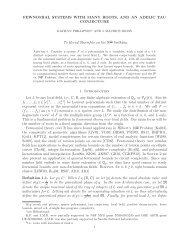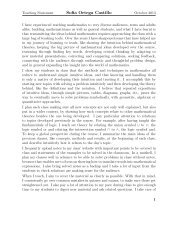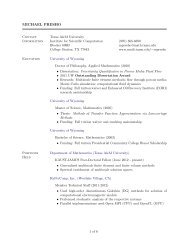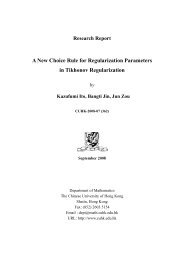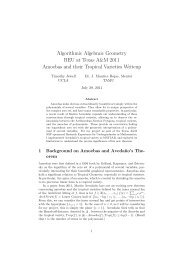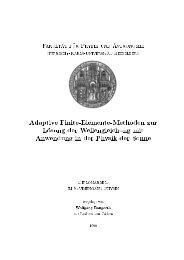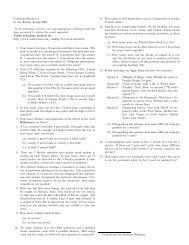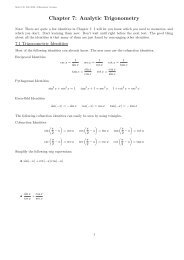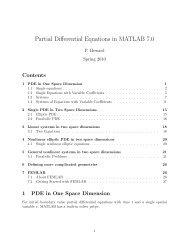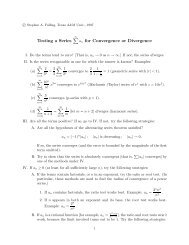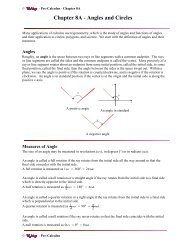Tensors: Geometry and Applications J.M. Landsberg - Texas A&M ...
Tensors: Geometry and Applications J.M. Landsberg - Texas A&M ...
Tensors: Geometry and Applications J.M. Landsberg - Texas A&M ...
You also want an ePaper? Increase the reach of your titles
YUMPU automatically turns print PDFs into web optimized ePapers that Google loves.
18 1. Introduction<br />
algebra class you learned the Laplace expansion - given a 2 × 2 matrix<br />
� �<br />
a b<br />
c d<br />
its determinant is ad − bc, then given an n × n matrix X = (x i j ),<br />
det(x i j) = x 1 1∆1,1 − x 1 2∆1,2 + · · · + (−1) n−1 x 1 n∆1,n<br />
where ∆i,j is the determinant of the (n − 1) × (n − 1) matrix obtained by<br />
deleting the i-th row <strong>and</strong> j-th column of X. This algorithm works fine for<br />
3 × 3 <strong>and</strong> 4 × 4 matrices, but by the time one gets to 10 × 10 matrices, it<br />
becomes a bit of a mess.<br />
Aside 1.4.1.1. Let’s pause for a moment to think about exactly what we are<br />
computing, i.e., the meaning of det(X). The first thing we learn is that X<br />
is invertible if <strong>and</strong> only if its determinant is nonzero. To go deeper, we first<br />
need to remind ourselves of the meaning of an n ×n matrix X: what does it<br />
represent? It may represent many different things - a table of data, a bilinear<br />
form, a map between two different vector spaces of the same dimension, but<br />
one gets the most meaning of the determinant when X represents a linear<br />
map from a vector space to itself. Then, det(X) represents the product of<br />
the eigenvalues of the linear map, or equivalently, the measure of the change<br />
in oriented volume the linear map effects on n-dimensional parallelpipeds<br />
with one vertex at the origin. These interpretations will be important for<br />
what follows, see, e.g., §13.4.2 but for now we continue our computational<br />
point of view.<br />
The st<strong>and</strong>ard formula for the determinant is<br />
(1.4.1) det(X) = �<br />
σ∈Sn<br />
sgn(σ)x 1 σ(1) · · · xn σ(n)<br />
where Sn is the group of all permutations on n elements <strong>and</strong> sgn(σ) is the<br />
sign of the permutation σ : {1,... ,n} → {1,... ,n}. The formula is a sum<br />
of n! terms, so for a 10 ×10 matrix, one would have to perform 9(10!) ≃ 10 7<br />
multiplications <strong>and</strong> 10! − 1 additions to compute the determinant.<br />
The st<strong>and</strong>ard method for computing the determinant of large matrices<br />
is Gaussian elimination. Recall that if X is an upper triangular matrix,<br />
its determinant is easy to compute: it is just the product of the diagonal<br />
entries. On the other h<strong>and</strong>, det(gX) = det(g)det(X), so multiplying X by<br />
a matrix with determinant one will not change its determinant. To perform<br />
Gaussian elimination one chooses a sequence of matrices with determinant<br />
one to multiply X by until one obtains an upper triangular matrix whose<br />
determinant is then easy to compute. Matrix multiplication, even of arbitrary<br />
matrices, uses on the order of n 3 scalar multiplications (actually less,<br />
as discussed in §1.1), but even executed naïvely, one uses approximately n 4



